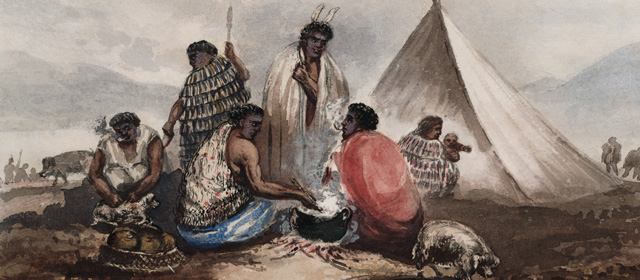Story summary
Growing and gathering
The ancestors of the Māori brought edible plants from their homeland, including kūmara, yam and taro. In Aotearoa (New Zealand) the climate was colder than home and Māori used sophisticated cultivation techniques to adapt these crops to the new environment.
Aotearoa was originally covered with dense native bush, and its wild ferns, vines, palms, fungi, berries, fruit and seeds became important foods.
Māori introduced kiore (the Polynesian rat) and kurī (the Polynesian dog), both valuable sources of meat. They hunted a wide range of birds, and seafood was vital to their diet.
Cooking and preserving
The hāngī (earth oven) is a traditional method of cooking, especially suited to feeding large numbers of people. Smaller quantities of food were cooked in or over embers.
Māori did not make pottery, so their only means of boiling was to place a red-hot stone in a wooden bowl of liquid.
They preserved large quantities of food by drying it, fermenting it, or sealing it in fat. The food was stored in pātaka (storehouses) or rua kūmara (underground pits).
Traditional foods
Important foods included whitebait, the seaweed karengo, huhu grubs, pikopiko (fern shoots), karaka berries and toroi – a dish of fresh mussels with pūhā (sow thistle) juice.
Introduced foods
When Pākehā settlers arrived in Aotearoa, Māori embraced the new foods they brought, and began cultivating them. These crops included wheat, potatoes, maize, carrots, cabbage and other vegetables. Māori also began raising sheep, pigs, goats and poultry.
Potatoes were easier to grow than kūmara, and pigs could be fattened quickly, so pork, pūhā and potatoes became a new staple meal. Called the ‘boil-up’, it remained popular in the 21st century.
Contemporary cuisine
Since the late 20th century traditional Māori foods have been prepared and presented in new ways to suit the modern palate. New products have also been developed from ancient ingredients, ensuring Māori cuisine continues to be enjoyed by many people in New Zealand and internationally.





